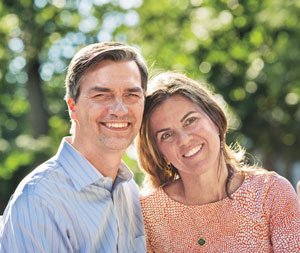Although the movies would have us believe otherwise, a long, happy marriage isn’t a matter of simply finding the right person. Lasting love requires commitment and developing healthy habits that can sustain through both good and bad times. It’s not just about romance; as it turns out, there’s actually a science to making love last.

LIVE HAPPY: Many books explain how to achieve greater happiness; what made you want to write about the topic of happiness specifically as it relates to couples?
JAMES & SUZANN: Although there were many excellent research studies demonstrating the potential to help couples, no one had put them together into an easily accessible format or book. There was a lot of interest on the topic, but not much out there in the popular media. We saw writing the book together as a shared project we could undertake to help develop and strengthen our own marriage while simultaneously providing a resource that could help other couples, as well.
LH: What’s the biggest misconception people have about happiness and relationships?
J&S: That “happily ever after” just happens. That’s not the case, except in fairy tales and films.
LH: How does your book help change that perception?
J&S: It demonstrates, through scientific research and real-life examples, that healthy habits are what build happiness over the long haul. Becoming happy together is an ongoing process comprised of sustained effort and conscious cultivation of healthy habits.
LH: Were there any new things that you learned about your relationship through the process of writing this book together?
J&S: That our unique strengths that initially attracted us to one another and helped build our bond are also the strengths that, when not understood and respected in one another, can cause pain and misunderstanding.

LH: Aspects of each of you shine through in this book—and really serve as a great illustration of how you apply the give and take in a
relationship. How did you work through any challenges that arose from developing/writing this book?
J&S: We practiced mindfulness meditation. At times when we needed a breather, that’s what we literally did. We took a break and some deep breaths. We were then able to return to the task at hand and work together better.
LH: Although it’s about happiness as a couple, this book also is a great introduction to positive psychology for those who haven’t yet experienced it. How do you think people can use these relationship lessons in other areas of their lives?
J&S: We feel that the interaction model of strengths that we developed—an approach that focuses on not just how we express love, gratitude and kindness, for example, but also how we respond to them—are important for all relationships. This approach can be used and practiced in our daily interactions, not just with our spouses and romantic partners but also with family, friends, colleagues and acquaintances.
LH: What’s the No. 1 thing you hope readers take away from your book?
J&S: Building love that lasts takes effort. It doesn’t just happen. And that effort needs to be well directed. A good way to direct that effort is to find and feed the good in yourself and your partner, rather than focusing on problems and what’s wrong in the relationship. And scientific research in positive psychology gives specific, effective ways of finding and feeding the good.
(Visited 715 times, 1 visits today)


